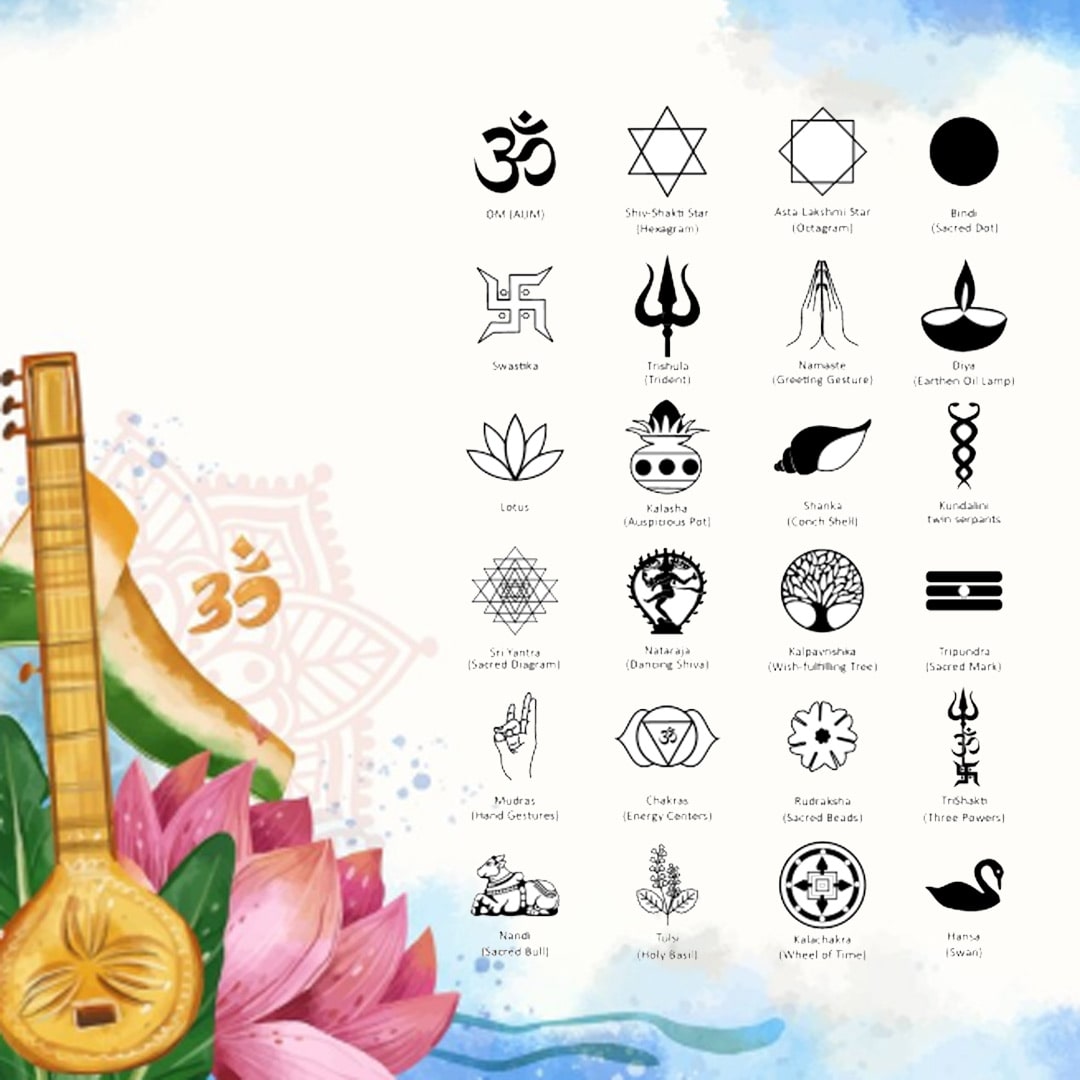

Please enter the code we just sent to whatsapp 91-11-46710500 to proceed
Didn't Receive OTP?

Symbols are sort of secret messages. They are not necessarily words, but they are very important in meaning. Symbols are all around us in Hinduism—temple and holiday, stories and traditions, everywhere! Symbols can assist us in learning about such grand things as truth, courage, peace, and the cosmos!
This site is your magical introduction to Hindu symbols and meaning—specifically created for curious little minds. So, get a grip on your imagination and let's go on a colorful adventure and discover Hindu symbols for kids!
Think of a sound that unites everything on the planet. That's Om (also called AUM). It's not only a symbol—it's a sacred word, used while praying and meditating.
What it means:
Om represents the beginning, center, and end of all that is created.
It represents Lord Brahma (the creator), Vishnu (the preserver), and Shiva (the destroyer).
It's the sound of peace and balance.
Kids Tip: Say "Om" to relax your mind and improve concentration while studying or sleeping.
Don't get it confused with other meanings—the Swastika is an old and cheerful Hindu religious symbol.
What it signifies:
Four arms represent truth, order, prosperity, and energy.
Bestowing blessings, good fortune, and good energy.
Usually drawn on festivities, poojas, or on new books and diaries.
Fun Fact: "Swasti" translates to well-being in Sanskrit!
Did you ever see a lotus blooming in the foulest pond? That's the miracle—it remains above the muck and appears to be pure. No surprise it's a sweetheart of the most common Hindu symbols and their meanings are rich in inspiration.
What it means:
Purity even in adversity.
It's the abode of gods such as Lakshmi and Saraswati.
It instructs us to transcend problems and remain beautiful from within.
Try This: Color your own lotus and shade it with pink or white!
Lord Shiva wields a powerful weapon known as the Trishul, a trident or three-point spear. But it is not only an instrument—it's richly religious in significance.
What it means:
Three points are symbolic of mind, body, and soul.
It is a symbol of smashing evil and guarding truth.
Reminds us to stay balanced in our thoughts, actions, and religion.
Kids' Thought: Use your "inner Trishul" to fight fear, laziness, and vices!
You may have seen the older folks with a red or yellow spot on the forehead. That is a Tilak, and when it is round and put on by females, it is called a Bindi.
What it means:
Wear on the Ajna Chakra—the spot of wisdom.
Symbolizes concentration, spiritual energy, and grace.
Also brings in a dash of tradition and refinement.
Activity: Create a bright tilak with turmeric or kumkum (with an adult) and be a little devotee!
Nandi is the patient bull who stands outside Shiva temples. He's not just adorable—he's meaningful.
What it means:
Faith, patience, and devotion.
Reminds us to wait patiently and in faith.
Tells us how to become God's true friend.
Did You Know? Wishes are whispered softly in Nandi's ear in the hope Lord Shiva will hear it!
Kalash is a metal pot filled with water, mango leaves, and a coconut kept on top of it. You may have seen it at weddings, festivals, and poojas.
What it means:
Symbolizes life, creation, and prosperity.
The kalash represents the Earth, the water is life, and the coconut is wisdom.
It welcomes happiness and purity to the home.
Craft Time: Attempt to make a paper Kalash and decorate it for Diwali or Navratri!
The Chakra, particularly the Sudarshan Chakra of Lord Vishnu, is a wheel of power that turns.
What it means:
Goodness and truth never cease to move, like a wheel.
Also, it reminds us of the cycle of birth, life, and rebirth.
Ashoka Chakra on the Indian flag draws inspiration from this!
The Shankha is blown during pooja. It makes a sound that is perceived to be powerful and divine.
What it means:
Drives away evil energy.
Trophy of victory, purity, and divine voice.
With Lord Vishnu, the protector.
Sound Play: Have your teacher or elder demonstrate a Shankha—nature's trumpet!
It is not a tree. The Peepal tree in Hinduism is holy and imparts spiritual energy.
What it is:
Represents long life, peace, and shelter.
Lord Krishna boasts of dwelling in the Peepal among the trees!
People wrap threads upon it to wish.
Nature Note: Sit under a Peepal tree and feel the serenity—it is pure magic!
The sweet ringing of a temple bell is not music—it stirs our senses and summons in the divine.
What it is:
Erases distractions and calls in attention.
Represents clarity, being present, and aware.
The bell is said to ring in the universal vibration of Om!
Try This: Close your eyes the next time you hear a temple bell and see what is there within.
Training children about the symbols of Indian spirituality assists in:
Become associated with ancient wisdom.
Develop an appreciation for our culture in an enjoyable way.
Be guided by principles of truth, peace, courage, and patience.
Cultivate respect and appreciation for other traditions too. These symbols are not just temple material—these are part of who we are, shining like little lanterns along the path of life.
Shape Your Kid's Future with Bambinos Classes | World’s first Bhagavad Gita course for Kids | Click here to Book a Free Class Limited time offer.